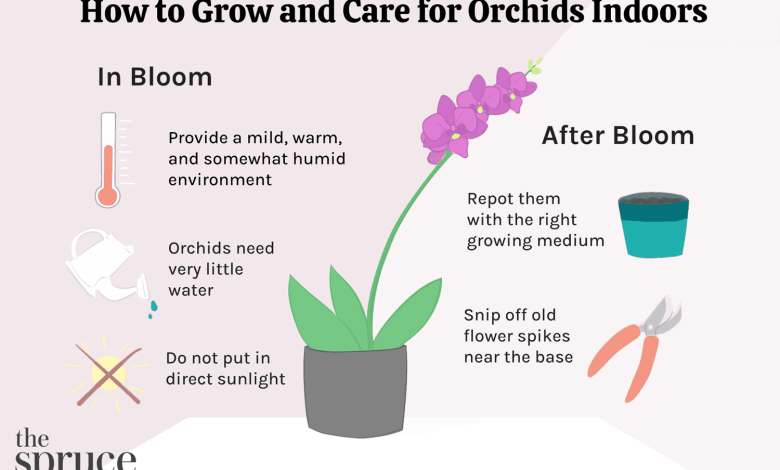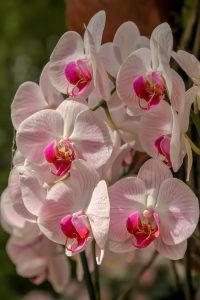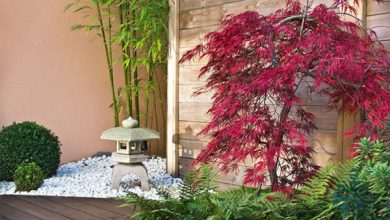Orchid Care in Winter: [Soil, Pruning and Problems]

What characteristics do orchids have in winter?

In the impressive world of flowers, orchids occupy a privileged place.
And is not for less. Many of its thousands of species (25,000 have been classified) come from tropical areas of the planet.
But they have managed to adapt to the whims of millions of admirers who have placed them in seats of honor in their homes, in showcases, boxes, flower arrangements, bridal bouquets.
How to take care of them in seasonal countries, where winter can wreak havoc?
Even though many species have managed to acclimatize after leaving their original habitats, it is also true that they do not get along with intense cold, much less with snow or frost.
There are species that vary their way of life according to temperature. There are, in fact, cold climate orchids, such as the Odontoglossum and Cymbidium genera. But there are also species that are better adapted to temperate climates such as Cattleyas and some Oncidium.
Those of warm climate include genera such as Phalaenopsis and Vanda. You have to be a little more careful in the cold months. Let’s see what is the ABC of orchids in winter.
What soil needs do orchids have in winter?
It is always best to use substrates rich in organic matter, if they are specific for orchids it is much better, because the nutrients will balance perfectly and the plant will have sufficient defenses to face the toughest months of the year.

Making sure that the substrate is always permeable, that it filters the water, is essential. A highly recommended substrate to fill a pot is the following, based on peat:

Remember that it is not good to give them common soil, because their roots need air and then a looser and more porous mixture is better. As a general rule, Phalaenopsis and Cattleya orchids should have a substrate composed of:
- 4 parts medium grain fir bark or coconut shell.
- 1 part medium grain charcoal of vegetable origin.
- 1 part perlite.
Regarding the application of fertilizers, it is good to remember that although most varieties of orchids stop their growth process in the winter, this does not prevent them from preparing to face flowering.
They need potassium and calcium, because they are nutrients that they cannot take from the substrate. So the use of orchid fertilizers will also be reduced to two applications per month with half the dose that is normally applied. Every 15 days in autumn and winter will do you good.

The idea is to prevent it from continuing to use its energy potential to grow, because it would be without defenses to withstand low temperatures and would end up totally weakened, with wrinkled leaves and a bad appearance in general.
Towards the end of winter is also a favorable time to carry out a transplant and provide the plant with a new substrate, of course, whenever necessary. The stress on the plant will be much less because we will not be interfering with its plant cycle and we will give it the strength to face full flowering in spring.
How to make orchids grow strong and vigorous in winter?
Orchids aren’t as fragile as we think, but they need to be helped to stay healthy in the colder months of the year, when plants are supposed to go dormant. Two factors of great importance are temperature and lighting, keys to a long floral life.
Temperature
When temperatures begin to drop, orchids suffer if they spend the night in climates below 10ºC, the species does not matter, they all suffer, so first of all, shelter them inside the house, because it is essential to prevent them from receiving cold drafts, since the leaves are spoiled.
We must not forget that the ideal temperature for orchids is between 10-27ºC, depending on the variety, because there are some that can flower precisely in the grayest months of the year.

And it is that in the winter months the orchids need to have the maximum energy to protect themselves while they wait for the arrival of the time with the greatest wear and tear, that of flowering.
Although it is unlikely that an orchid will give us flowers in the winter, its floral stem will be more alive than ever and must be preserved with certain minimum stable lighting and temperature conditions. If you feel comfortable, you are able to lavish some flowers in advance as a reward for our excellent services.
Lightning
 It is also very important to place the plant near a large window or in a warm environment with good daily natural lighting, so that it remains healthy.
It is also very important to place the plant near a large window or in a warm environment with good daily natural lighting, so that it remains healthy.
But taking care that drafts never surprise you. You have to keep it away from that danger, as well as from direct sunlight.
South facing windows are perfect in winters. If there is no balance and the plant receives little light, which in winter is left over because everything turns grey, dark, the leaves turn yellow.
If this eventuality happens, you have to move them to a more illuminated place very quickly or it will dry out.
In short, if the orchids do not receive good light they will not flower. When they receive adequate light the leaves have a dark green color but if they turn yellow or reddish they are receiving excessive light that can kill the plant.
What humidity do orchids need in winter?
Regarding the humidity, it is absolutely necessary to maintain a controlled irrigation, scarce, poor in winter. Excessive humidity is one of its worst enemies and in winter low temperatures prevent a correct and rapid drying of its delicate roots.
The ideal level of humidity for the happy life of orchids is between 60-70%. But if it is necessary to increase the humidity in a room, place a tray with pebbles and water, just below the orchid. Or use a humidifying device.
It is also positive to take her to the bathroom. Or have them on top of a carpet of moss. Or put a surface layer of equal amounts of white stones (limestone), black stones and ground pine bark, all small.

Therefore, irrigation should be reduced to half normal. It is an inviolable order that must be fulfilled under frequent observation of its roots.
Hence, it is important to monitor the change of color in the roots, without forgetting that when they are painted green and they thicken they are satisfied and when they turn whitish it means that they need a moderate watering, free of lime, free of minerals that can also spoil it. hopelessly.
The water will be much better used if it has a temperature of about 37ºC. It should never be cold. The ideal is to water in the morning, early, because in this way we play with the temperature and avoid the proliferation of fungi, great cause of the worst diseases in orchids.
Is it necessary to prune orchids in winter?
Pruning helps the plant to flourish generously. Eliminating dry leaves and flowers is essential to achieve this. Floral stems that have dried should also be cut.
Of course, the pruning shears must be disinfected with alcohol beforehand.
How often should we prune orchids in winter?
Pruning proceeds after flowering and when you see that the stem begins to turn yellowish and that it does not have any knots.
How to avoid orchid pests and diseases in winter?
The ills that afflict them generally come as a result of attacks by fungi and bacteria, but as long as excess humidity is avoided and good ventilation is provided, they can remain healthy.
What comes then is a correct application of ecological fungicides recommended by specialists. Likewise, it is good to always keep the plant clean, as well as its surroundings.

However, there is a pest that can aggravate the fungal problem, the presence of aphids. These are combated with the preventive application of nettle purin, either in the morning or in the afternoon.
Another way to eliminate them is with the application of potassium soap on the underside of their leaves to clean them of the molasses excreted by this annoying pest.

Another unwelcome visitor is spider mites, tiny but effective at ruining the plant. They are eliminated with a concentrated preparation of garlic and chili. They are also afflicted by a disease called brotitis, which attacks the flowers as a result of excess moisture.

They must be eliminated, destroyed because if they are carelessly thrown away then they can contribute to the spread of evil. Leaves are also affected when humidity is excessive. They turn yellow and fall off. So it is necessary to apply the right amount of water in each irrigation.
Maybe you are also interested in:
- How often and how to water my orchids in winter?
- 6 Types and Varieties of Most Famous Orchids
- Fertilize Orchids: How, When and How Much? – Sow100
- Learn to Take Care of your Dendrobium: Everything You Need
- White Orchid Care: [Soil, Moisture, Pruning and Problems]
- Phalaenopsis Orchid Care: [Soil, Humidity, Pruning and Problems]
- Orchid Care: [Soil, Humidity, Pruning and Problems]
- Orchid Cuttings: [Grafts, Time, Rooting and Planting]
- Orchid Pests and Diseases: [Detection, Causes and Solutions]
- Types of Orchids: [Characteristics and Classification]




